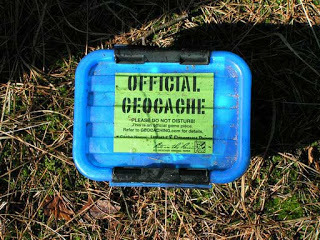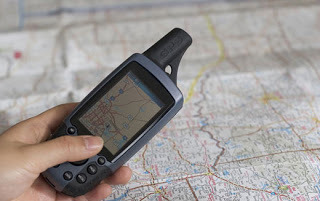Geocatching: A Modern Day Treasure Hunt
Geocatching: A Modern Day Treasure Hunt
Technology plus hide and seek equals geocaching. With over 1,092,192 geaocaches worldwide, geocaching entices adults to relieve their childhood in the wilderness. Adults from over 100 countries on all continents participate in the game. The game requires skills in benchmarking, trigpointing, orienteering, treasure-hunting, letterboxing, and waymarking. Equipment includes a GPS, waterproof container, logbook and a few small trinkets.
 Invented on May 6, 2000 by Dace Ulmer of Beavercreek, Oregon the game continues to grow in popularity. A person who plays the game is known as a geocacher. The geocacher gathers a waterproof container, a log book, pencil and a tradable trinket. Tradable trinkets ideas include books, unusual coinage, small toys, ornamental buttons, and CD's. Most trade objects do not hold high monetary values but are sentimental to the finder. Sometimes a cache may also contain a geocoin or travelbug. These two objects, known to geocachers as hitchhikers, travel from one cache to another. Their exploits are available online. Never place food or something that smells inside the container. Stolen or vandalized geocaches are termed "muggled" or "plundered." "Muggles" are considered those who are unfamiliar with geocaching. Owners of the catch are responsible for maintaining the containers and objects. Waterproof containers may be as small as a finger to as large as five gallon buckets.
Invented on May 6, 2000 by Dace Ulmer of Beavercreek, Oregon the game continues to grow in popularity. A person who plays the game is known as a geocacher. The geocacher gathers a waterproof container, a log book, pencil and a tradable trinket. Tradable trinkets ideas include books, unusual coinage, small toys, ornamental buttons, and CD's. Most trade objects do not hold high monetary values but are sentimental to the finder. Sometimes a cache may also contain a geocoin or travelbug. These two objects, known to geocachers as hitchhikers, travel from one cache to another. Their exploits are available online. Never place food or something that smells inside the container. Stolen or vandalized geocaches are termed "muggled" or "plundered." "Muggles" are considered those who are unfamiliar with geocaching. Owners of the catch are responsible for maintaining the containers and objects. Waterproof containers may be as small as a finger to as large as five gallon buckets.
Once the geocacher has their treasures he or she chooses a location to bury their treasures. Locations may vary. Some geocache hiding places involve complex searches such as underwater, located 50 feet in a tree, staged multi caches, long off-road drives, high mountain peaks or in challenging environments. Urban environments also contain geocaches. Terms such as "drive-bys", "park 'n grab" and "cache and dash" refer to simpler geocaches.
Once placed in the ground the geocacher uploads the coordinates to the geocatching website. There are many geocaching websites worldwide. The largest geocaching website, Geocaching.com lists over 100,000,000 caches worldwide. Their free membership allows anyone access to geocaching locations. A paid, premium membership grants the geocacher extra search tools and member only geocache locations.
 Finding a geocache can be as fun as burying one. On the website of their choice the geocacher locates a caches coordinates. They place the coordinators inside their GPS and begin their search. The search may leave lead to places they've never been before. Once the geocacher arrives to the cache's location reveal the container. They open the container, take out the logbook and sign it. Logbooks entries document who and where the geocacher came from and when the treasure was found. The geocacher then takes the trinket from the container only to replace it with a new one then reburies the cache. If a geocoin or travel bug accompanies the trinket they log into the site, placed the coordinates where it was found then bury it with their next geocache discovery.
Finding a geocache can be as fun as burying one. On the website of their choice the geocacher locates a caches coordinates. They place the coordinators inside their GPS and begin their search. The search may leave lead to places they've never been before. Once the geocacher arrives to the cache's location reveal the container. They open the container, take out the logbook and sign it. Logbooks entries document who and where the geocacher came from and when the treasure was found. The geocacher then takes the trinket from the container only to replace it with a new one then reburies the cache. If a geocoin or travel bug accompanies the trinket they log into the site, placed the coordinates where it was found then bury it with their next geocache discovery.
A fun game with wonderful variations, the game creates controversy. Governmental and public opponents claim geocaching is only a collective effort to place more litter in the environment. In attempt to show otherwise, geochacers often travel with trash bags and pick up litter while searching. In 2005 South Carolina House of Representatives, in attempt to hinder geocaching, passed Bill 3777 stated, "It is unlawful for a person to engage in the activity of geocaching or letterboxing in a cemetery or in an historic or archeological site or property publicly identified by an historical marker without the express written consent of the owner or entity which oversees that cemetery site or property." The bill was sent to the Senate. The bill never left the Senate. Geocaching is legal in the United States.
 Invented on May 6, 2000 by Dace Ulmer of Beavercreek, Oregon the game continues to grow in popularity. A person who plays the game is known as a geocacher. The geocacher gathers a waterproof container, a log book, pencil and a tradable trinket. Tradable trinkets ideas include books, unusual coinage, small toys, ornamental buttons, and CD's. Most trade objects do not hold high monetary values but are sentimental to the finder. Sometimes a cache may also contain a geocoin or travelbug. These two objects, known to geocachers as hitchhikers, travel from one cache to another. Their exploits are available online. Never place food or something that smells inside the container. Stolen or vandalized geocaches are termed "muggled" or "plundered." "Muggles" are considered those who are unfamiliar with geocaching. Owners of the catch are responsible for maintaining the containers and objects. Waterproof containers may be as small as a finger to as large as five gallon buckets.
Invented on May 6, 2000 by Dace Ulmer of Beavercreek, Oregon the game continues to grow in popularity. A person who plays the game is known as a geocacher. The geocacher gathers a waterproof container, a log book, pencil and a tradable trinket. Tradable trinkets ideas include books, unusual coinage, small toys, ornamental buttons, and CD's. Most trade objects do not hold high monetary values but are sentimental to the finder. Sometimes a cache may also contain a geocoin or travelbug. These two objects, known to geocachers as hitchhikers, travel from one cache to another. Their exploits are available online. Never place food or something that smells inside the container. Stolen or vandalized geocaches are termed "muggled" or "plundered." "Muggles" are considered those who are unfamiliar with geocaching. Owners of the catch are responsible for maintaining the containers and objects. Waterproof containers may be as small as a finger to as large as five gallon buckets. Once the geocacher has their treasures he or she chooses a location to bury their treasures. Locations may vary. Some geocache hiding places involve complex searches such as underwater, located 50 feet in a tree, staged multi caches, long off-road drives, high mountain peaks or in challenging environments. Urban environments also contain geocaches. Terms such as "drive-bys", "park 'n grab" and "cache and dash" refer to simpler geocaches.
Once placed in the ground the geocacher uploads the coordinates to the geocatching website. There are many geocaching websites worldwide. The largest geocaching website, Geocaching.com lists over 100,000,000 caches worldwide. Their free membership allows anyone access to geocaching locations. A paid, premium membership grants the geocacher extra search tools and member only geocache locations.
 Finding a geocache can be as fun as burying one. On the website of their choice the geocacher locates a caches coordinates. They place the coordinators inside their GPS and begin their search. The search may leave lead to places they've never been before. Once the geocacher arrives to the cache's location reveal the container. They open the container, take out the logbook and sign it. Logbooks entries document who and where the geocacher came from and when the treasure was found. The geocacher then takes the trinket from the container only to replace it with a new one then reburies the cache. If a geocoin or travel bug accompanies the trinket they log into the site, placed the coordinates where it was found then bury it with their next geocache discovery.
Finding a geocache can be as fun as burying one. On the website of their choice the geocacher locates a caches coordinates. They place the coordinators inside their GPS and begin their search. The search may leave lead to places they've never been before. Once the geocacher arrives to the cache's location reveal the container. They open the container, take out the logbook and sign it. Logbooks entries document who and where the geocacher came from and when the treasure was found. The geocacher then takes the trinket from the container only to replace it with a new one then reburies the cache. If a geocoin or travel bug accompanies the trinket they log into the site, placed the coordinates where it was found then bury it with their next geocache discovery.A fun game with wonderful variations, the game creates controversy. Governmental and public opponents claim geocaching is only a collective effort to place more litter in the environment. In attempt to show otherwise, geochacers often travel with trash bags and pick up litter while searching. In 2005 South Carolina House of Representatives, in attempt to hinder geocaching, passed Bill 3777 stated, "It is unlawful for a person to engage in the activity of geocaching or letterboxing in a cemetery or in an historic or archeological site or property publicly identified by an historical marker without the express written consent of the owner or entity which oversees that cemetery site or property." The bill was sent to the Senate. The bill never left the Senate. Geocaching is legal in the United States.
Published on February 24, 2012 02:17
No comments have been added yet.



